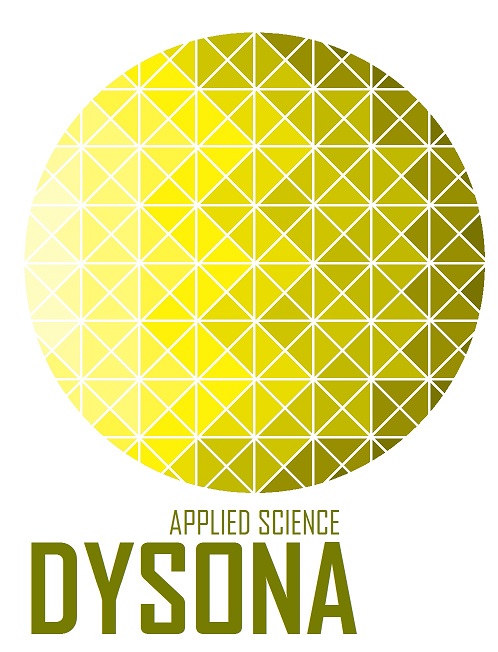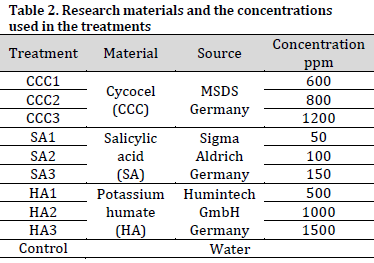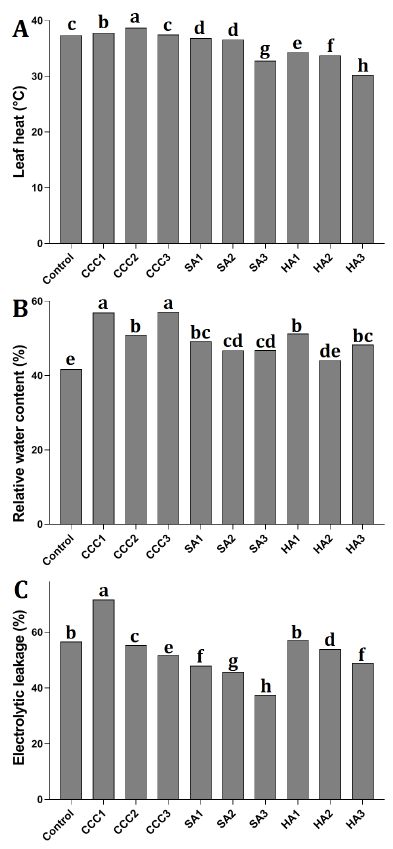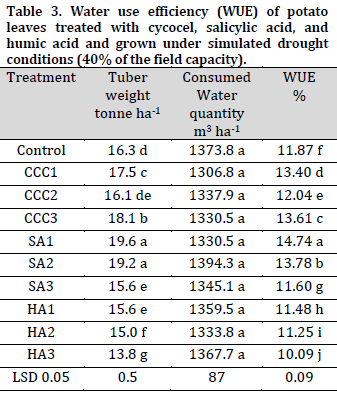Hadia Hassan 1*; Maher Dais 1; Sawsan Suleiman 2
1, Al-Hinady Research Station, Latakia Center, General Commission for Scientific Agricultural Research (GCSAR) Latakia, Syria
2, Horticulture Department, Faculty of Agriculture, Tishreen University, Latakia, Syria
E-mail:
hadiahasan894@gmail.com
Received: 03/05/2023
Acceptance: 28/06/2023
Available Online: 29/06/2023
Published: 01/07/2023

Manuscript link
http://dx.doi.org/10.30493/DAS.2023.395764
Abstract
In this study, the effect of the foliar spray with different concentrations of cycocel (600, 800, and 1200 ppm), salicylic acid (50, 100, and 150 ppm), and humic acid (500, 1000, and 1500 ppm) on potato grown under simulated water stress conditions (40% of field capacity) was studied. For that purpose, a completely randomized experiment was conducted in the spring season of 2019-2020 at Al- Hennadi research center, Lattakia, Syria. Potato plants were sprayed with the prepared solutions after 35 days of planting (tuber imitation stage) at ten days intervals three times. Leaf temperature, relative water content, electrolytic leakage, and water use efficiency were measured in treated plants and compared to the control. The results showed that all three substances (cycocel, salicylic acid, and humic acid) improved water stress resistance characteristics in potatoes. Cycocel was the most efficient in increasing relative water content at 1200 ppm concentration. On the other hand, salicylic acid at 50 ppm increased relative water content, water use efficiency, and electrolytic leakage compared to the control.
Keywords: Potato, Water stress, Cycocel, Salicylic acid, Humic acid
Introduction
Potato occupies an important place in world food security. It ranks as the first food crop after major cereals, and the fourth in yield volume after wheat, corn, and rice [1]. Potato is also considered an important food source of carbohydrates in developing countries due to its low production costs [2].
Soil humidity is one of the most important factors in tuber yield and quality [3]. Potato sensitivity to water stress depends on its growth stage [4], and the tuber formation stage is the most sensitive. Water stress reduces vegetative area [5] and photosynthesis rate [6], which in turn delay tuber formation [7] and decrease tuber number and yield [8]. The adverse effect of water stress is attributed to the accumulation of reactive oxygen species (ROS), which causes protein degradation, lipids oxidation, destruction of plasma membranes, pigments bleaching [9], and modification of antioxidant enzymes activity [10].
The relative water content, leaf temperature, stomata conductance, and transpiration rate are important indicators that reflect the water relations in plants [11]. The release of water vapor in transpiration regulates the temperature of the plant’s aerial parts and helps in reducing the heat generated by light absorption [12]. Various studies highlighted the importance of the vegetative surface temperature and its association with the productivity of several crops under water stress [13][14]. Additionally, the occurrence of electrolyte leakage in water stress causes an irreversible loss of potassium by the plant during the stress response [15].
Chlorocholinechloride (CCC) ClCH2CH2N+(CH3)3.Cl (commercially known as Cycocel) is a plant growth regulator that inhibits gibberellin synthesis [16]. CCC affects plant height, leaf number, leaf surface index, plant dry weight, chlorophyll activity, photosynthetic components, and mineral uptake, in addition to amino acid and protein contents [17]. It also regulates stomatal conductance and reduces transpiration, which increases the relative water content and water use efficiency [18]. Furthermore, CCC increases the chloroplasts’ number in addition to chlorophyll and carotenoid content and improves photosynthesis efficiency [19]. It is worth mentioning that CCC treatment increased the stomata resistance and chlorophyll content of potato plants exposed to water stress conditions [20].
Salicylic Acid [(SA) (C7H6O3)] is an endogenous plant hormone and a non-antioxidant enzyme [21]. Many Studies indicate that SA can be used to mitigate the negative effect of drought on plants by controlling stomata closure, maintaining chlorophyll content, increasing water use efficiency, and stimulating root growth [22][23]. Additionally, SA can improve relative water content and reduce electrolyte leakage in tomato plants subjected to drought stress [24].
Humic Acid (HA) is a complicated natural organic compound [25] that is proven to increase the yield and quality of many economic crops [26], including potatoes [27]. Additionally, humic acid improves plant resistance to drought stress [28] by increasing the activity of hormones and enzymes [29]. Previous results showed that HA treatment increases plant growth, photosynthesis, and antioxidant metabolism under water stress conditions [31].
In Syria, low soil humidity resulting from the unbalanced distribution of rainfall and limited irrigation resources reduces potato yield. Therefore, this study aimed to inspect the potentials of cycocel, salicylic acid, and humic acid application in alleviating the adverse drought stress effects and enhancing water use efficiency in potatoes.
Material and Methods
Cultivation and experimental treatments
This study was carried out at Lattakia Agriculture Research Center during the spring season of 2020-2021 at Al-Hanadi Research Station. In order to control water input in the experimental field, a metal structure with a polyethylene cover was used (Fig. 1). Soil analysis showed that it had a loamy sandy texture with adequate organic matter, high phosphorus, and average potassium contents (Table 1). ‘Spunta’ potato tubers were planted manually in the field at a depth of 10 cm with 30×70 cm distances between the plants within the line and between the lines, respectively.
The field capacity was estimated and calculated in the laboratory by weighing 2 kg of soil (W1) in a pot of known weight, which was irrigated with one liter of water. After 24 hours, the soil of the pot was weighed again (W2). The amount of water remaining in the soil was considered as the amount needed to achieve a field capacity of 100% by weight of the soil. field capacity (FC%) was then calculated according to the formula:




Fertilizers were applied based on the soil analysis results (Table 1), and according to the Ministry of Agriculture recommendation for potato fertilizing (370 kg ha-1 of urea and 240 kg ha-1 of potassium sulfate) [31].
The plants were irrigated uniformly after planting until complete germination (One month after planting). After germination, irrigations were applied until 40% of the soil field capacity was reached.
For the experimental treatments, three concentrations of cycocel (600, 800, and 1200 ppm), salicylic acid (50, 100, and 150 ppm), and humic acid (potassium humate C9H8K2O4: 500,1000,1500 ppm) were prepared in water (Table 2). Potato plants were sprayed with the prepared solutions after 35 days of planting (tuber imitation stage) at ten days intervals three times.
Studied characteristics
Leaf temperature
The leaf temperature was measured using an infrared thermometer (Evenntek E300).
Relative water content (RWC%)
The relative water content (RWC%) was estimated according to [32] by taking five fresh leaves and weighing them directly (fresh weight). Then, the leaves were immersed in distilled water for 24 hours (in a dark place). The weight was measured again (weight at fullness). The leaves were then dried again at a temperature of 80 °C until a constant weight (dry weight) was achieved. The relative water content was then calculated according to the formula:

Electrolytic leakage (EL%)
Electrolytic leakage was estimated by cutting several plant leaves into equal sections and placing them in test tubes with distilled water. The tubes were left in the laboratory temperature for 24 hours. Then, the electrical conductivity of the leaf solution (EC1) was measured using an electrical conductivity device (Thermo Orion- Benchtop Conductivity Meter-Model 162A). After that, the tubes were placed in a water bath at 100 °C for 60 minutes. Then, the second electrical conductivity reading (EC2) was taken. The EL% owing to damaged cells under water stress conditions was estimated according to [15].

Water use efficiency (WUE)
Water use efficiency refers to the amount of dry matter produced by a consumed water unit by evaporation, transpiration, and the amount of water used in plant tissue building [33]. The water use efficiency of potato plants was estimated using the following formula [34]:

Where
WUE: Water use efficiency (kg m-3)
P: Yield per planted area unit (kg ha)
W: The amount of consumed irrigation water per area unit (m3 ha)
Statistical analysis
The experiment was conducted in a completely randomized design. In total, 280 potato plants with 42 plants and three blocks (14 plants per block) in each treatment were used. The resulting data were analyzed using COSTAT software and the differences between means were compared using Duncan’s test at p<0.05 [35].
Results
Leaf heat
The results showed that SA and HA treatments significantly reduced the leaf temperature compared with the control plants under water stress. The lowest leaf temperature was observed in HA3 at 30.24 °C. On the other hand, the highest temperature measurements were in CCC-treated plants, with CCC2, recording the highest temperature (38.68) followed by CCC1 (37.8 °C) and CCC3 (37.5 °C). It is worth noting that both CCC1 and CCC2 reads were significantly higher than the control (Fig. 2 A).

Relative Water Content (RWC)
All treatments recorded higher RWC values compared to the control (Fig. 2 B). This increase in RWC was more pronounced in CCC treatments, as CCC1, CCC2, and CCC3 recorded 56.34, 50.49, and 57.11% higher than the control, respectively. This increase in RWC compared with the control was also decent in HA and SA treatments; however, it was not significant in HA2.
Electrolytic leakage (EL)
All SA treatments resulted in a significant decrease in EL compared with to control, with SA3 treatment recording the lowest EL (37.45%). On the other hand, only higher CCC and HA levels (CCC2, CCC3, HA2, and HA3) recorded lower EL values compared with the control. It was also noted that CCC1 had the highest EL value with 71.69% (Fig. 2 C).
Water Use Efficiency (WUE)
Few treatments resulted in an increase in tuber yield per hectare compared to the control (CC1, CC3, SA1, and SA2). Among these treatments, SA1 was the most superior with 19.6 tonne ha-1. On the other hand, HA treatments appeared to have negative effects on tuber yield, with HA3 scoring the lowest among all treatments (13.8 tonne ha-1) (Table 3).
Similarly, SA1 scored the highest WUE value (14.74%) followed by SA2 (13.78%), while HA treatments scored the lowest values with HA3 being the lowest among all treatments (10.09%).

Discussion
Drought-tolerant potato cultivars, such ‘Spunta’, are characterized by higher relative water content, stomatal transmission, and photosynthetic rate, in addition to increased root system elongation and tubers content of carbohydrates compared to drought-sensitive cultivars [36]. Other studies showed that the high stomatal conductance and relative water content in leaf tissues in tolerant crops under water stress conditions may be attributed to increased water absorption efficiency from the soil or other adaptive ways [37].
The currently observed decreased relative water content in the control leaves was associated with an increase in electrolytic leakage rate. The increase in electrolytic leakage under low soil humidity may be mainly due to the influx of potassium ions, in order to adapt to stress conditions [38]. The accumulation of free radicals reduces membrane stability and increases its permeability [39]. Thereafter, these radicals activate potassium influx channels [40]. The current results agree with previous reports of higher electrolytic leakage in okra [41] and potato [42] plants exposed to water stress.
Plant growth inhibitors reduce leaf area, which contributes to the reduction of transpiration rate [43]. Although CCC treatments did not reduce the temperature of stressed potato leaves in the current study, a significant increase in relative water content and a decrease in electrolyte leakage were observed in CCC-treated plants compared with the control. This observation may be attributed to CCC role in regulating stomata conductance, which reduces the rate of transpiration and gas exchanges, maintaining the relative water content in the leaf tissue [44]. Similar works highlighted the role of CCC in reducing the transpiration rate, which results in an increase in water use efficiency, in addition to its effect in increasing root growth due to an increase in indole acetic acid (IAA) production [22].
As for SA treatment, a noticeable increase in relative water content in addition to the reduction in leaf temperature and electrolytic leakage was observed. This observation may be attributed to the effect of SA in closing stomata, maintaining chlorophyll content, increasing water use efficiency, and stimulating root growth [22]. Furthermore, salicylic acid protects the cell membrane and proteins syntheses by mitigating oxidative stress damage [45][46][47][48]. Similar to previous reports in beans and artichokes [21][48], the current results showed that SA treatment can increase the relative water content in potato leaves. The results are also consistent with [41] as electrolytic leakage declined in SA-treated okra leaves compared to untreated plants.
The positive effect of potassium humate in improving the physical indicators of stressed potato plants is due to it being a rich source of minerals, especially potassium which regulates the opening and closing mechanism of stomata [49] preventing water vapor exit under water stress, which leads to an increase relative water content. Also, it is known that humic acid increases the cell membrane permeability, mineral elements absorption, chlorophyll pigments activation, and formation, and the sugars and amino acids syntheses [50] that prevent the lipids oxidation in cell membranes and increase antioxidants. Therefore, all these positive effects of HA lead to a decrease in electrolyte leakage in stressed plants (similar to the current HA2 and HA3 treatments). These results are consistent with previous reports where HA treatment increased relative water content and decreased electrolyte leakage in leaves [51].
Plants developed a physiological system to raise water use efficiency by decreasing water loss in respiration and maintaining leaf water content by controlling stomatal conductance, leaves number, and area [52]. However, these responses reduce the photosynthetic rate [53]. Similar to many other plants, water stress decreases respiration and photosynthesis in potatoes, which increases water use efficiency [54][55][56]. The current results further showed an increase in water use efficiency in CCC- and SA-treated plants. CCC is proven to stimulate root growth and limit evaporation and increases water use efficiency [45]. SA on the other hand induces stomata closing and increases CO2 percentage, chlorophyll content, and relative water content in cells [57]. Additionally, SA enhances photosynthesis [58] and photosynthesis products transporting [59], which justifies the currently observed high water use efficiency results under SA treatment. These results are in line with those previously seen in potatoes [60].
Conclusion
The treatment with CCC, SA, and HA improved water stress resistance characteristics in potatoes. Cycocel was the most efficient in increasing relative water content at 1200 ppm concentration. Furthermore, salicylic acid at 50 ppm concentration increased relative water content, water use efficiency, and electrolytic leakage in stressed plants.
References
| 1 | FAO. FAO statistical databases FAOSTAT. 2019. |
| 2 | Romero AP, Alarcón A, Valbuena I R, Galeano HC. Physiological Assessment of Water Stress in Potato Using Spectral Information. Front. Plant Sci. 2017;8:1608. DOI |
| 3 | El-Ghamry AM, El-Shikha MD. Effects of different irrigation systems and nitrogen fertilizer sources on potato growth and yield. J. Agric. Sci. 2004;29(11):6393-410. DOI |
| 4 | Alva AK. Set points for potato irrigation in sandy soils using real-time, continuous monitoring of soil-water content in soil profile. J. Crop. Improv. 2008;21(2):117-37. DOI |
| 5 | Fleisher DH, Timlin JD ,Reddy RV. Interactive effects of CO2 and water stress on potato canopy growth and development. Agron J. 2008;100(3):711-9. DOI |
| 6 | Deblonde P M K, Ledent J F. Effects of moderate drought conditions on green leaf number, stem height, leaf length and tuber yield of potato cultivars. Eur. J. Agron. 2001;14(1):31-41. DOI |
| 7 | Walworth J, Carling D.Tuber initiation and development in irrigated and non-irrigated potatoes. Am. J. Potato Res. 2002;79:387–95. DOI |
| 8 | Havaerkort AJ, Van DE Waart M, Bodlaender AK. The effect of early drought stress on numbers of tubers and stolons of potato in controlled and field conditions. Potato Res .1990;33:89-96. DOI |
| 9 | De Vos CH, Schat H. Free radicals and heavy metal tolerance. Ecological responses to environmental stresses. 1991:22-30. |
| 10 | Hasan SA, Hayat S. Ali B, Ahmad A. Homobrassinolide protects chickpea (Cicer arietinum) from cadmium toxicity by stimulating antioxidants. Environ. Poll. 2008;151:60-6. DOI |
| 11 | Siddique MRB, Hamid A, Islam SM. Drought stress effects on water relations of wheat. Bot. Bull. Acad. Sin. 2000;41:35-9. |
| 12 | Bouzerzour H, Benmahammed A. Variation in Early Growth, Canopy Temperature, Translocation and Yield of Four Durum Wheat (Triticum durum Desf.) Genotypes under Semi-Arid Conditions. Jordan J. Biol. Sci. 2009;5(2):142-54. |
| 13 | Prashar A, Yildiz J, McNicol JW, Bryan GJ, Jones HG. Infra-red Thermography for High Throughput Field Phenotyping in Solanum tuberosum. PLoS ONE. 2013;8(6):e65816. DOI |
| 14 | Leinonen I, Grant OM, Tagliavia CPP, Chaves MM, Jones HG. Estimating stomatal conductance with thermal imagery. Plant Cell Environ. 2006;29:1508–18. DOI |
| 15 | Bajji M, Lutts S, Kinet JM. Water deficit effects on solute contribution to osmotic adjustment as a function of leaf aging in three durum wheat (Triticum durum Desf.) cultivars performing differently in arid conditions. PlantSci. 2001;160(4):669-81 DOI |
| 16 | Hoque M, Haque S. Effects of GA3 and its mode of application on morphology and yield parameters of mungbean (Vigna radiate L.). Pak J Biol Sci. 2002;5(3):281-3. DOI |
| 17 | Khan N, Syeed S, Masood A, Nazar R, Iqbal N. Application of Salicylic Acid Increases Contents of Nutrients and Antioxidative Metabolism in Mungbean and Alleviates Adverse Effects of Salinity Stress. Int. J. Plant Biol. 2010;1(1). DOI |
| 18 | Nejadsahebi M, Moallemi N, Lanndi AN. Effects of Cycocel and Irrigation Regimes on Some Physiological Parameters of Three Olive Cultivars. Am. J. Appl. Sci. 7 (4):459-65 DOI |
| 19 | Wang HQ, Xiao LT. Effects of chlorocholine chloride on phytohormones and photosynthetic characteristics in potato (Solanum tuberosum L.). J. Plant Growth Regul. 2008;28(1):21–7. DOI |
| 20 | Ranjbar A, Imani A, Piri S, Abdoosi V. Effects of drought stress on almond cultivars responses grafted on different rootstocks. Journal of Nuts. 2019;10(1):9-24. DOI |
| 21 | El-Tohamy H, Maher E, Badr M A A, Gruda N. Effect Of Exogenous Salicylic Acid On The Response Of Snap Bean (Phaseolus vulgaris L.) And Jerusalem Artichoke (Helianthus tuberosus L.) To Drought Stress. Acta Sci. Pol. Hortorum Cultus. 2018;17(4):81–91. DOI |
| 22 | Anosheh HP, Emam Y, Ashraf M, Foolad MR. Exogenous application of salicylic acid and chlormequat chloride alleviates negative effects of drought stress in wheat. Adv. Stud. Biol. 2012;4:501-20. |
| 23 | Ashraf M, Akram AN, Arteca NR, Foolad RM. The Physiological, Biochemical and Molecular Roles of Brassinosteroids and Salicylic Acid in Plant. Crit. Rev. Plant Sci. 2010;29(3):162-90. DOI |
| 24 | Hayat S, Hasan SA, Fariduddin Q, Ahmad A. Growth of tomato (Lycopersicom esculentum) in response to salicylic acid under water stress. J. Plant Interact. 2008;3:297–304. DOI |
| 25 | Mikkelsen RL. Humic materials for agriculture. Better Crops. 2005;89(3):6-10. |
| 26 | Alenazi M, Wahb-Allah AM, Abdel-Razzak SH, Ibrahim AA, Abdullah Alsadonl L .Water Regimes and Humic Acid Application Influences Potato Growth, Yield, Tuber Quality and Water Use Efficiency. Am. J. Potato Res. 2016;93:463-473. DOI |
| 27 | Kumar D, Singh PA, Raha P, Rakshit A, Singh MC, Kishor P. Potassium Humate: A Potential Soil Conditioner and Plant Growth Promoter. Inter. J. Agric. Environ. Biotechnol. 2013;6(3):441-446. DOI |
| 28 | Man-Hong Y, Lei Z, Sheng-Tao X, McLaughlin NB, Jing-Hui L. Effect of water soluble humic acid applied to potato foliage on plant growth, photosynthesis characteristics and fresh tuber yield under different water deficits. Sci Rep. 2020;10(1):7854. DOI |
| 29 | Sarir MS, Sharif M, Ahmed Z, Akhlaq M. Influence of different levels of humic acid application by various methods on the yield and yield components of maize Sarhad. J. Agric. Sci. 2005;21(1):75-81. |
| 30 | Fahramand M, Moradi H, Noori M, Sobhkhizi A, Adibian M, Abdollahi S, Rigi K. Influence of humic acid on increase yield of plants and soil properties. Int. J. Farming Allied Sci. 2014;3 (3):339-41. |
| 31 | AL-Zuabi M, Al-Husni A, Dergham H. Methods of analyzing soil, plants, fertilizers and water. General Authority for Scientific Agricultural Research-Ministry of Agriculture and Agraian Reform –Syrian Arab Republic. 2013:223. |
| 32 | Barrs HD, Weatherley PE. A Re-Examination of the Relative Turgidity Techniques for Estimating Water Deficits in Leaves. Aust. Bio. Sci. 1962;15:413-428. DOI |
| 33 | Al-Khateeb AS, Abdullatif A, Al-Khateeb AA, El-Beltagi SH, Sattar NM.Genotypic Variation For Drought Tolerance in Three Date Palm (Phoenix Dactylifera L.) Cultivars. Fresenius Environ. Bull.2019;28 (6):4671-83. |
| 34 | Reddy V, Reddy A. Proteomics of Calcium-Signaling Components in Plants. Phytochem. 2004;65:1745-76. DOI |
| 35 | Duncan B D. Multiple range and multiple F-test Biometricalf. International Biometric Society. 1955;11:1-42. DOI |
| 36 | Graca JP, Rodrigues AF, Farias BRJ, Oliveira NCM, Hoffmann-Campo BC, Zingaretti MS. Physiological parameters in sugarcane cultivars submitted to water deficit. Braz. J. Plant. Physiol.2010;22(3):189-97. DOI |
| 37 | Blum A. Effective use of water (EUW) and not water-use efficiency is the target of crop yield improvement under drought stress. Field Crops Res. 2009;112(2-3):119–23. DOI |
| 38 | Demidchik V, Straltsova D, Medvedev MS, PozhvanovAG, SokolikA ,YurinV. Stress-induced electrolyte leakage:the role of K+ -permeable channels and involvement in programmed cell death and metabolic adjustment. J. Exp. Bot. 2014;65( 5):1259–70. DOI |
| 39 | Meena KK, Sorty AM, Bitla UM, Choudhary K, Gupta P, Pareek A, Singh DP, Prabha R, Sahu PK, Gupta VK, Singh HB, Krishanani KK, Minhas PS.Abiotic stress responses and microbe-mediated mitigation in plants:the omics strategies. Front. Plant Sci.2017;8:172. DOI |
| 40 | Demidchik V ,Cuin AT, Svistunenko D, Smith JS, Miller JA, Shabla S, Sokolik A, Yuriin V. Arabidopsis root K+-efflux conductance activated by hydroxyl radicals:single-channel properties, genetic basis and involvement in stress-induced cell death. J Cell. Sci. 2010;123:1468-1479. DOI |
| 41 | Ayuba Q, Khana MS, Mehmoodb A, Haqc UN, Alia S, Ahmadd T, Ayuba UM, Hassaana M, Hayata U, Shoukata FM. Enhancement of Physiological and Biochemical Attributes of Okra by Application of Salicylic Acid under Drought Stress. J. Hortic. Sci. Technol. 2020;3(4):113-9. DOI |
| 42 | Rodríguez-Pérez L, Ñústez L, Patricia LCE, Moreno F. Drought stress affects physiological parameters but not tuber yield in three Andean potato(Solanum tuberosum L.)cultivars. Agron. Colomb. 2017;35(2):158. DOI |
| 43 | Luoranen J, Rikala R, Aphalo PJ.Effect of CCC and damonozide on growth of silver birch container seedlings during three years after spraying. New For. 2002;23:71-80. DOI |
| 44 | Khalilzadeh R, Sharifi SR, Jalilian J. Antioxidant status and physiological responses of wheat (Triticum aestivum L.) to cycocel application and bio fertilizers under water limitation condition. J. Plant Interact. 2016;11(1):130-37. DOI |
| 45 | Savchenko T, Tikhonov K. Oxidative Stress-Induced Alteration of Plant Central Metabolism. Life. 2021;11(4):304. DOI |
| 46 | Hashempour A, Ghasemnezhad M, Ghazvini RF, Sohani MM. The physiological and biochemical responses to freezing stress of olive plants treated with salicylic acid. Russ J Plant Physiol. 2014;61:443–50. DOI |
| 47 | Pourghayoumi M, Bakhshi D, Rahemi M, Kamgar-Haghighi AA, Aalami A. The physiological responses of various pomegranate cultivars to drought stress and recovery in order to screen for drought tolerance. Sci. Hortic.2017;217:164-72. DOI |
| 48 | Larque-Saavedra A. Stomatal closure in response to acetylsalicylic acid treatment. Z. Pflanzenphysiol. 1979;93(4):371-5. |
| 49 | Knudson LL, Tibbitts TW, Edwards EG. Measurement of Ozone injury by determination of leaf chlorophyll concentration. Plant Physiol. 1977;60:606-8. DOI |
| 50 | Abdel latif YMI, Abdel- Ati YY, Abdel-Mageed TY, Hassan MAM. Effect of Humic Acid on Growth and Productivity of Tomato Plants Under Heat Stress. J. Hortic. Res. 2017;25(2):59-66. DOI |
| 51 | Mahdi A, Badawy S, Latef AA, El Hosary A, El Razek UA, Taha R. Integrated Effectsof Potassium Humate and Planting Density on Growth, Physiological Traits and Yield of Vicia faba L. Grown in Newly Reclaimed Soil. Agronomy 2021;11:461. DOI |
| 52 | Lerna A, Mauromicale G. How moderate water stress can affect water use efficiency indices in potato. Agronomy. 2020;10(7):1034. DOI |
| 53 | Gervais T, Creelman A, Li X-Q, Bizimungu B, De Koeyer D, Dahal K. Potato Response to Drought Stress: Physiological and Growth Basis. Front. Plant Sci. 2021;12. DOI |
| 54 | Ahmadi SH, Andersen MN, Plauborg F, Poulsen RT, Jensen CR, Sepaskhah AR, Hansen S. Effects of irrigation strategies and soils on field grown potatoes: Yield and water productivity. Agric. Water Manag. 2010;97,1923–30. DOI |
| 55 | Fandika IR, Kemp PD, Millner JP, Horne D. Irrigation and nitrogen effects on tuber yield and water use efficiency of heritage and modern potato cultivars. Agric. Water Manag. 2016;170, 148–57. DOI |
| 56 | Abou El-Khair EE. Dalia AS, Nawar HME. Ismail Effect of Irrigation Water Quantity and Farmyard Manure on Potato Plant Growth in Sandy Soil. Egypt. J. Agric. Res. 2011;89(1). DOI |
| 57 | Ashraf M. Biotechnological Approach of Improving Plant Salt Tolerance Using Antioxidants as Markers. Biotechnol. Adv. 2009;27:84–93. DOI |
| 58 | Qi R, Gu W, Zhang J, Hao L, Zhang M, Duan L. Exogenous diethyl aminoethyl hexanoate enhanced growth of corn and soybean seedlings through altered photosynthesis and phytohormone. Aust. J. Crop Sci. 2013;7:2021–28. |
| 59 | Liu YH, Zhang XH, Liu BW, Ao B, Liu Q, Wen SY, Xu YF. Hydrogen sulfide regulates photosynthesis of tall fescue under low-light stress. Photosynthetica. 2019;57(3):714-23. DOI |
| 60 | Metwaly EE, El-Shatoury SR. Impact of Foliar Application with Salicylic Acid on Growth and Yield of Potato (Solanum tuberosum L.)under Different Irrigation Water Quantity. J. Plant Pro. 2017;8(10):969-77. DOI |
Cite this article:
Hasan, H., Dais, M., Suleiman, S. Leaves attributes and water use effeciency of potatoes grown under water stress after cycocel, salicylic acid, and humic acid sprays. DYSONA – Applied Science, 2023;4(2): 62-70. doi: 10.30493/das.2023.395764
